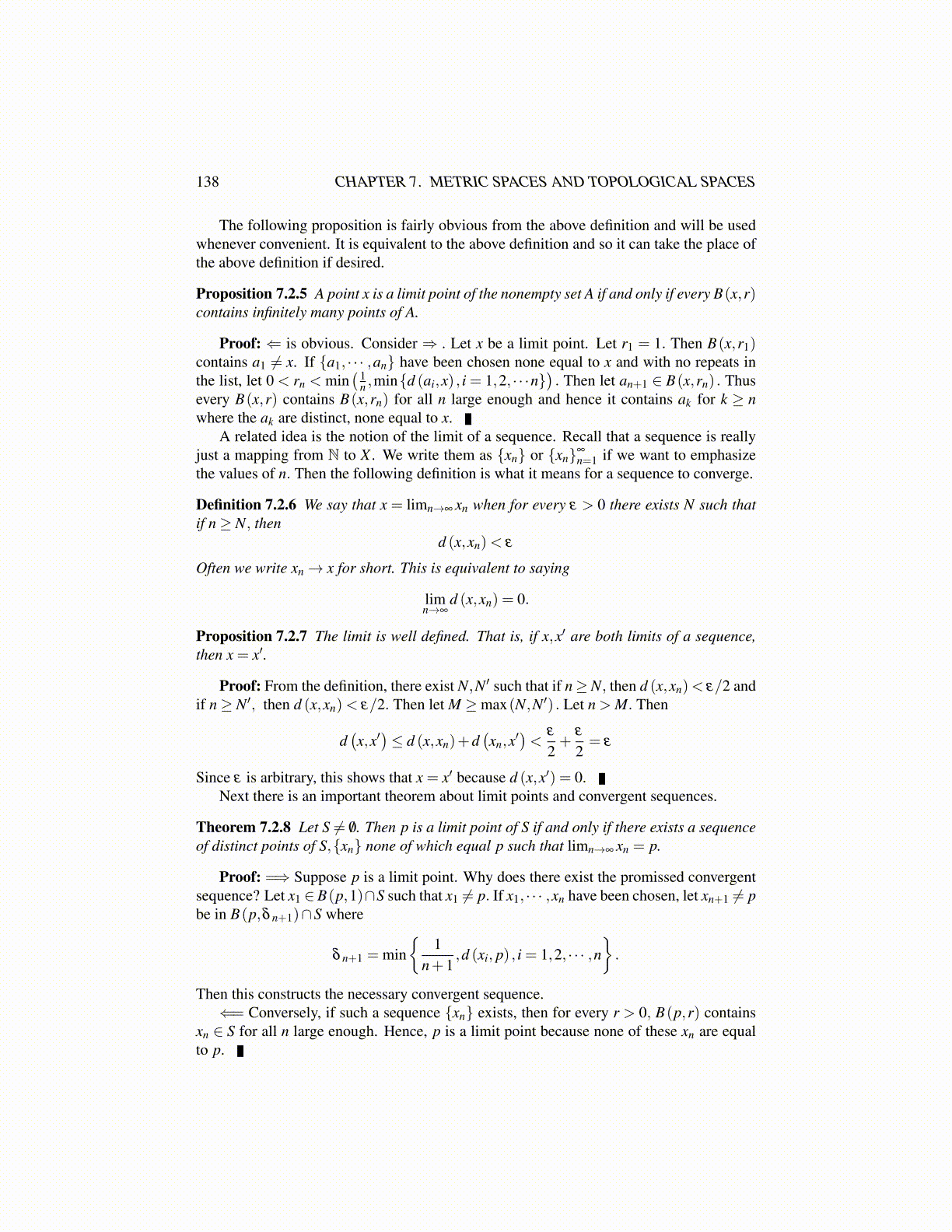
138 CHAPTER 7. METRIC SPACES AND TOPOLOGICAL SPACES
The following proposition is fairly obvious from the above definition and will be usedwhenever convenient. It is equivalent to the above definition and so it can take the place ofthe above definition if desired.
Proposition 7.2.5 A point x is a limit point of the nonempty set A if and only if every B(x,r)contains infinitely many points of A.
Proof: ⇐ is obvious. Consider ⇒ . Let x be a limit point. Let r1 = 1. Then B(x,r1)contains a1 ̸= x. If {a1, · · · ,an} have been chosen none equal to x and with no repeats inthe list, let 0 < rn < min
( 1n ,min{d (ai,x) , i = 1,2, · · ·n}
). Then let an+1 ∈ B(x,rn) . Thus
every B(x,r) contains B(x,rn) for all n large enough and hence it contains ak for k ≥ nwhere the ak are distinct, none equal to x.
A related idea is the notion of the limit of a sequence. Recall that a sequence is reallyjust a mapping from N to X . We write them as {xn} or {xn}∞
n=1 if we want to emphasizethe values of n. Then the following definition is what it means for a sequence to converge.
Definition 7.2.6 We say that x = limn→∞ xn when for every ε > 0 there exists N such thatif n≥ N, then
d (x,xn)< ε
Often we write xn→ x for short. This is equivalent to saying
limn→∞
d (x,xn) = 0.
Proposition 7.2.7 The limit is well defined. That is, if x,x′ are both limits of a sequence,then x = x′.
Proof: From the definition, there exist N,N′ such that if n≥N, then d (x,xn)< ε/2 andif n≥ N′, then d (x,xn)< ε/2. Then let M ≥max(N,N′) . Let n > M. Then
d(x,x′)≤ d (x,xn)+d
(xn,x′
)<
ε
2+
ε
2= ε
Since ε is arbitrary, this shows that x = x′ because d (x,x′) = 0.Next there is an important theorem about limit points and convergent sequences.
Theorem 7.2.8 Let S ̸= /0. Then p is a limit point of S if and only if there exists a sequenceof distinct points of S,{xn} none of which equal p such that limn→∞ xn = p.
Proof: =⇒ Suppose p is a limit point. Why does there exist the promissed convergentsequence? Let x1 ∈B(p,1)∩S such that x1 ̸= p. If x1, · · · ,xn have been chosen, let xn+1 ̸= pbe in B(p,δ n+1)∩S where
δ n+1 = min{
1n+1
,d (xi, p) , i = 1,2, · · · ,n}.
Then this constructs the necessary convergent sequence.⇐= Conversely, if such a sequence {xn} exists, then for every r > 0, B(p,r) contains
xn ∈ S for all n large enough. Hence, p is a limit point because none of these xn are equalto p.